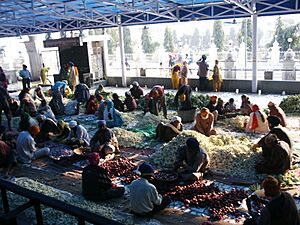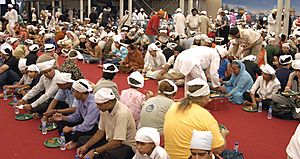Langar facts for kids
The langar (Punjabi: ਲੰਗਰ, Hindi: लंगर) is a special kitchen found in every Sikh temple (called a gurdwara). Here, free food is served to everyone who visits. It doesn't matter who you are or where you come from.
Only vegetarian food is served at the langar. Common meals include bread (like poori), yogurt, and lentils. Sometimes, on special days, you might find Samosas or spring rolls. A sweet dish like Kheer might also be served for dessert.
The langar is open to both Sikhs and people of any other faith. After eating at a langar, people are asked not to eat meat for the rest of that day.
What Does 'Langar' Mean?
The word Langar comes from the Persian language. It was later adopted into the Punjabi language.
How Langar Started
Giving free food to travelers and people in need has been a tradition in many cultures for a very long time. In India, there were places like dharma-shala or dharma-sattra at Hindu temples. These places offered food and rest to travelers and the poor.
However, these older kitchens often had rules about who could eat. Sometimes, people were not allowed based on their caste or religion. For example, Hindus might not eat at Muslim kitchens, and vice versa.
The idea of the langar as we know it today was made popular by Guru Nanak. He was the founder of Sikhism around the year 1500 CE in Punjab, India. Guru Nanak wanted to create a place where everyone could eat together. It didn't matter their religion, caste, skin color, age, or social status. This made langar a powerful symbol of equality and sharing.
The second Sikh Guru, Guru Angad, helped organize the langar system even more. He made sure that all Sikh temples had a langar. Visitors could get a simple, free meal and sit together as equals. He also taught volunteers (called sevadars) how to run the kitchen. They learned to be polite and welcoming to everyone.
The third Sikh Guru, Guru Amar Das, made langar a very important part of Sikh life. He said that anyone who wanted to speak with him first had to eat at the langar. This helped to truly show that everyone was equal.
Langar Today

Today, langars are found in gurdwaras all around the world. Many people, including those who are homeless, visit them. Volunteers serve food to everyone without any judgment.
Hundreds or even thousands of people often gather at gurdwaras to share a simple vegetarian meal. This tradition continues to show the Sikh values of equality, community, and selfless service.


